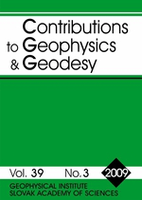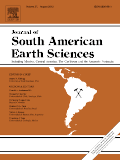
Russian Journal of Earth Sciences
Scope & Guideline
Exploring the depths of our planet's mysteries.
Introduction
Aims and Scopes
- Geological and Geophysical Research:
The journal extensively covers studies related to geological formations, tectonics, and geophysical phenomena. This includes seismic analysis, geomechanics, and the study of subsurface structures. - Environmental Monitoring and Management:
Research on environmental impacts and the management of natural resources is a core focus. This includes studies on pollution, climate change effects, and sustainable practices in various ecosystems. - Geoinformatics and Remote Sensing:
The integration of geoinformatics and remote sensing technologies is a recurrent theme, facilitating advanced data analysis and visualization for geological and environmental studies. - Hydrology and Oceanography:
The journal features research on hydrological processes and oceanographic studies, including the dynamics of bodies of water, sediment transport, and the impact of climate on aquatic systems. - Natural Hazards and Risk Assessment:
Papers addressing natural hazards such as earthquakes, landslides, and flooding are prominent, often focusing on risk assessment and mitigation strategies. - Mineral Resources and Exploration:
Research on mineral deposits, resource management, and exploration technologies is a significant area, including studies on the geochemical properties of minerals and their industrial applications.
Trending and Emerging
- Climate Change Adaptation and Resilience:
There is a growing emphasis on research that investigates the impacts of climate change on natural systems and explores strategies for adaptation and resilience in vulnerable regions. - Interdisciplinary Approaches to Geosciences:
An increasing number of studies are adopting interdisciplinary methodologies, integrating aspects of ecology, technology, and social sciences to provide comprehensive solutions to complex geoscientific problems. - Technological Innovations in Earth Sciences:
The use of advanced technologies such as machine learning, big data analytics, and remote sensing for geological research is on the rise, enhancing data accuracy and research efficiency. - Ecosystem Health and Sustainability:
Research focusing on the health of ecosystems, biodiversity, and sustainable resource management practices is becoming more prevalent, highlighting the journal's commitment to environmental stewardship. - Natural Disaster Preparedness and Mitigation:
There is an increasing focus on understanding and mitigating the impacts of natural disasters, with studies aimed at improving prediction models and community preparedness strategies.
Declining or Waning
- Traditional Geology:
There appears to be a waning interest in purely descriptive geological studies, with a shift towards more applied research that combines geology with technology and environmental considerations. - Static Climate Studies:
Research that focuses solely on static climate models without integrating dynamic environmental interactions or socio-economic impacts is decreasing, reflecting a trend towards more holistic approaches. - Historical Geosciences:
Themes centered around ancient geological processes and historical data analysis are becoming less prominent, as contemporary issues such as climate change and resource management take precedence.
Similar Journals

Remote Sensing
Advancing Knowledge in Earth and Planetary SciencesRemote Sensing is a highly esteemed journal published by MDPI, dedicated to the domain of Earth and Planetary Sciences. With an impressive impact factor reflected in its rank of #16 out of 195 in the general Earth and Planetary Sciences category, this journal achieves a commendable 92nd percentile among its peers, indicating its significant contribution to the field. Since its inception in 2009 as an Open Access journal, it has enabled researchers, professionals, and students from around the globe to access high-quality, peer-reviewed articles that delve into the latest advancements in remote sensing technologies, methodologies, and applications. Based in Switzerland, Remote Sensing serves as a vital platform for disseminating innovative research that supports and enhances our understanding of Earth's processes and environments, ensuring scientific knowledge remains freely accessible and impactful.

GEOSCIENCES JOURNAL
Pioneering Insights into Earth's Complex Systems.Welcome to the GEOSCIENCES JOURNAL, a pivotal publication in the fields of Earth and Planetary Sciences and Environmental Science, proudly presented by the Geological Society of Korea. Established in 1997, this journal has become a prominent platform for researchers, professionals, and students, offering a rich collection of peer-reviewed articles that explore a diverse array of geoscientific topics. With an impressive Q2 ranking in both Earth and Planetary Sciences and Environmental Science categories for 2023, it stands as an essential resource in the academic community. Though it operates under a traditional subscription model, GEOSCIENCES JOURNAL remains dedicated to advancing knowledge through rigorous research. Addressed from its headquarters in Seoul, South Korea, the journal aims to foster a deeper understanding of geosciences, encouraging innovation and collaboration in tackling today’s environmental challenges.

Vestnik of Saint Petersburg University Earth Sciences
Championing Open Access in Earth SciencesVestnik of Saint Petersburg University Earth Sciences, published by ST PETERSBURG UNIV PRESS, serves as a pivotal platform for the dissemination of innovative research within the fields of Earth Sciences, Environmental Science, Geography, and Geology. This journal, with an ISSN of 2541-9668 and an E-ISSN of 2587-585X, aims to foster scholarly communication and facilitate advancements in understanding the diverse and complex interactions within our planet's systems. Operating from the Russian Federation, the journal is unique in its commitment to an open-access model, making critical research accessible to a global audience of researchers, professionals, and students. Although currently classified in the Q4 quartile in several relevant categories, its ranking showcases the potential for growth and increased impact within the academic community. Aiming to converge ideas and findings from 2017 to 2024, the Vestnik of Saint Petersburg University Earth Sciences is dedicated to enriching the dialogue and supporting collaborative research efforts in disciplines crucial for sustainable development and environmental stewardship.

GEOTECTONICS
Pioneering Insights into Earth's Geological Processes.GEOTECTONICS is a distinguished academic journal published by PLEIADES PUBLISHING INC, focusing on key developments in the field of geology. Established in 1978, the journal has dedicated itself to exploring the intricate processes and phenomena associated with Earth's tectonic systems, making substantial contributions to Earth and Planetary Sciences. With an impressive impact factor reflected in its Q2 ranking within the Scopus category of Geology, GEOTECTONICS stands out as a valuable resource for researchers, professionals, and students alike. The journal offers a platform for rigorous peer-reviewed research that spans both fundamental theories and practical applications in geosciences, affirming its significance in fostering academic discourse and advancing geological knowledge. Although it currently does not offer open access, the journal's accessible format and continued publication through to 2024 ensures that it remains at the forefront of geoscientific inquiry.

Contributions to Geophysics and Geodesy
Exploring New Frontiers in Geophysics and GeodesyContributions to Geophysics and Geodesy is a distinguished open access journal dedicated to advancing the field of geophysics and geodesy, published by the SLOVAK ACADEMY OF SCIENCES, EARTH SCIENCE INSTITUTE. With a rich publication history since its inception in 1992 and a commitment to open access since 2009, this journal serves as a vital platform for disseminating innovative research and critical insights in Earth sciences. Although it currently holds a Q4 ranking in the Geophysics category and is positioned in the 29th percentile, it continues to foster scholarly dialogue and enhance the visibility of significant findings in the community. Situated in Slovakia, the journal's address underscores its international reach and relevance. Researchers, professionals, and students alike will find valuable resources and perspectives within its pages, aiming to bridge gaps in knowledge and contribute meaningfully to the ongoing global discourse in geophysical sciences.

Geofizicheskiy Zhurnal-Geophysical Journal
Exploring the Depths of Earth Science InnovationGeofizicheskiy Zhurnal-Geophysical Journal, published by the esteemed S I Subbotin Institute of Geophysics, National Academy of Sciences of Ukraine, stands as a vital resource for professionals and researchers in the field of geophysics. With an ISSN of 0203-3100 and an E-ISSN of 2524-1052, this journal is recognized for its rigorous peer-reviewed articles that delve into various aspects of geophysical research, including seismic studies, geodynamics, and Earth surface processes. Although currently not under an open access model, the journal maintains a commitment to disseminating high-quality research, thereby enriching the global geophysical community. The publication aims to foster collaboration and knowledge transfer among scientists and engineers while addressing complex geophysical challenges in a rapidly evolving landscape. By engaging with cutting-edge research, readers can expect to uncover insights that advance both theoretical understanding and practical applications in geophysical science.

JOURNAL OF SOUTH AMERICAN EARTH SCIENCES
Fostering Insights into Earth's Dynamic ProcessesJOURNAL OF SOUTH AMERICAN EARTH SCIENCES is a premier interdisciplinary journal dedicated to publishing high-quality research in the fields of Earth-Surface Processes, Geology, and Paleontology, making it an essential resource for scientists and researchers focused on South American geology and its diverse geological phenomena. Published by Pergamon-Elsevier Science Ltd in the United Kingdom, this journal has been instrumental in disseminating groundbreaking studies since 1988, showcasing contributions that push the boundaries of knowledge in Earth and Planetary Sciences. With an impressive Scopus ranking—positioning it in the 74th percentile for Paleontology and 71st for Geology—this journal not only reflects robust academic quality but also its commitment to addressing critical geological challenges in South America. Researchers will appreciate its objective of advancing understanding of geological processes while providing insights into past, present, and future Earth environments. Although available through traditional subscription models, the journal's vast repository of articles enriches the academic landscape, facilitating the sharing of vital research among professionals, students, and geological practitioners.

AIMS Geosciences
Advancing Earth Sciences through Open AccessAIMS Geosciences, published by the American Institute of Mathematical Sciences (AIMS), is an esteemed open-access journal that has been serving the geosciences community since its inception in 2015. With an ISSN of 2471-2132, the journal disseminates high-quality research pertaining to various disciplines within geosciences, including geology, meteorology, oceanography, and environmental science. By promoting freely accessible research findings, AIMS Geosciences aims to foster collaboration and innovation among researchers, professionals, and students alike. The journal upholds rigorous peer-review standards, ensuring that only the most impactful research is shared with the global academic community. Situated at the forefront of geoscientific inquiry, this journal not only enhances the visibility of cutting-edge research but also contributes significantly to the understanding of Earth's processes, making it an essential resource for anyone engaged in this vital field.

Visnyk of Taras Shevchenko National University of Kyiv-Geology
Illuminating the Path of Geological Discovery and InnovationVisnyk of Taras Shevchenko National University of Kyiv-Geology is a premier academic journal dedicated to advancing the field of geology and related earth sciences. Published by the esteemed NATL TARAS SHEVCHENKO UNIV KYIV, this journal serves as a vital platform for researchers, professionals, and students to disseminate original research findings, innovative methodologies, and comprehensive reviews that address contemporary geological challenges. With an ISSN of 1728-2713 and an E-ISSN of 2079-9063, the journal is committed to upholding rigorous academic standards and excellence, although it currently operates without an open access model. The Visnyk primarily focuses on topics such as mineralogy, geophysics, geological engineering, and environmental geology, thus providing a broad spectrum of insights into the ever-evolving discipline of geology. Situated in Kyiv, Ukraine, it not only fosters local research but also contributes to the global geological discourse, making it an indispensable resource for anyone engaged in earth sciences.

Environmental Earth Sciences
Unveiling the complexities of our planet through interdisciplinary studies.Environmental Earth Sciences is a prestigious journal published by Springer, dedicated to advancing knowledge in the multifaceted fields of Earth Sciences, including Earth-Surface Processes, Environmental Chemistry, Geology, and Soil Science. With an ISSN of 1866-6280 and an E-ISSN of 1866-6299, this journal occupies a notable position in the academic landscape, consistently ranked in the Q2 category across multiple disciplines in 2023. It supports open access to foster wider dissemination of impactful research, enhancing visibility and accessibility for authors and readers alike. The journal's ongoing commitment to publishing innovative studies and reviews makes it an essential resource for researchers, professionals, and students alike. With a strong focus on addressing contemporary environmental challenges, Environmental Earth Sciences invites contributions that are both original and interdisciplinary, making a significant impact in understanding Earth dynamics and sustainability.